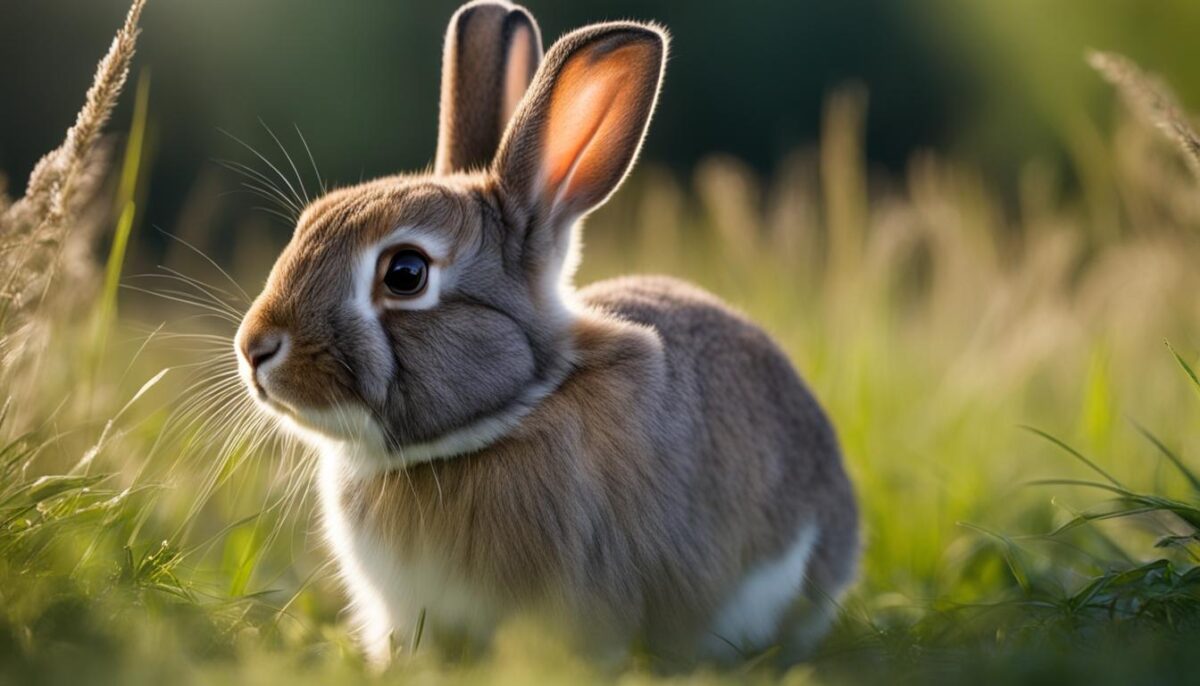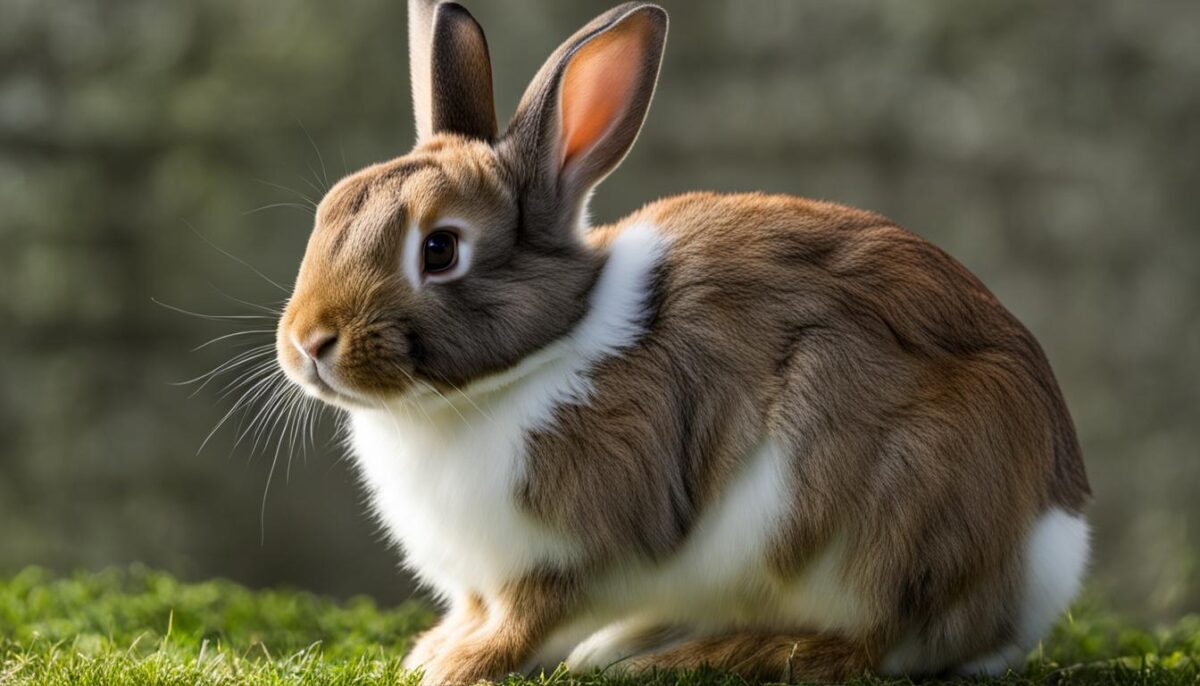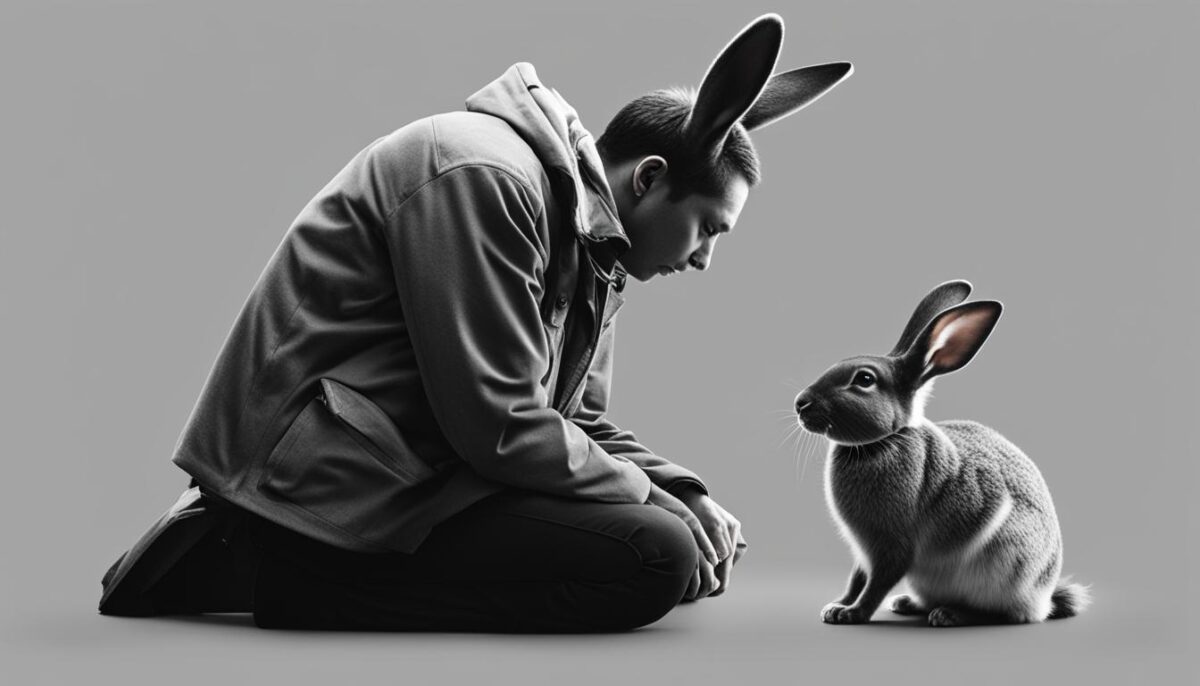Welcome to our comprehensive guide on understanding rabbit behavior and body language. As pet owners, it’s important to be able to interpret and respond to the signals our furry friends are sending us. One key aspect of rabbit communication is their ears and the various positions they take. By learning to decipher these ear movements alongside their overall body language, we can better understand our rabbits and ensure their well-being.
Key Takeaways:
- Understanding rabbit behavior and body language helps us communicate effectively with our furry friends.
- Rabbit ears play a significant role in conveying emotions and intentions.
- Different ear positions indicate various moods and behaviors.
- By observing and interpreting ear movements and body language, we can build a stronger bond with our rabbits.
- Pay attention to the context and overall body language to accurately interpret your rabbit’s messages.
When Rabbits Ears Are Back
The Importance of Rabbit Body Language
Rabbits, known for their adorable floppy ears, rely heavily on body language to communicate their needs and emotions. While they may not vocalize much, their ear movements play a significant role in conveying messages to humans. Understanding rabbit body language is crucial for interpreting their behavior accurately and providing appropriate care.
When observing a rabbit, it’s essential to consider the entire body language, including ear positions, to decode their intentions. Upright and relaxed ears typically indicate a calm and content rabbit, while ears standing straight up suggest alertness and attentiveness. Slanted ears forward display curiosity, caution, or interest in something new, while ears slanted backward may indicate anger, aggression, or self-defense.when rabbits ears are back
Additionally, rabbits lay their ears down along their back when they feel relaxed and safe, and wide-apart ears along their back signify a submissive posture. These ear positions, along with other body language signals, help us understand a rabbit’s emotions and respond accordingly. rabbit ears position
| Ear Position | Meaning |
|---|---|
| Upright and relaxed | Calm and content |
| Straight up | Alertness and attentiveness |
| Slanted forward | Curiosity, caution, or interest |
| Slanted backward | Anger, aggression, or self-defense |
| Laid down along the back | Relaxation and feeling safe |
| Wide apart along the back | Submissive posture |
By paying attention to a rabbit’s body language, we can build a stronger bond with our furry friends and ensure their well-being. It’s important to remember that each rabbit may have their own unique way of expressing themselves. By observing their ear movements and considering the context, we can better understand their behavior and provide the care they need.
The Meaning of Different Ear Positions in Rabbits
Understanding the meaning behind different ear positions in rabbits is essential for interpreting their body language and gaining insight into their emotions and intentions. Rabbits have remarkable control over their ears, using them as a vital communication tool. By observing their ear movements alongside their overall body language, you can better understand and connect with your furry friend.rabbit ear signals
Ear Positions and Their Meanings
Rabbits exhibit various ear positions, each conveying a different message. Here are some common ear positions and their interpretations:
| Ear Position | Meaning |
|---|---|
| Upright and relaxed | A calm and confident rabbit |
| Straight up | Alertness and attentiveness |
| Slanted forward | Curiosity and caution |
| Slanted backward at a rigid 45º angle | Anger, aggression, or self-defense |
| Laid down along the back | Relaxation and a sense of safety |
| Wide-apart along the back | Submissive posture |
| One ear up, one ear down | Lazily aware or engaged in activities |
It’s important to note that the meaning of ear positions can vary depending on the overall context and the rabbit’s other body language signals. Therefore, always consider the complete picture to accurately interpret your rabbit’s messages.

Just as our facial expressions and body language convey our emotions, rabbits use their ears to speak without words. By understanding the meaning behind different ear positions, we can nurture a deeper bond with these fascinating creatures and ensure their well-being.
Remember, interpreting rabbit ear language is just one aspect of understanding their body language. To fully comprehend their emotions and intentions, pay attention to other signals like body posture, vocalizations, and other behaviors. The more attuned you become to your rabbit’s communication style, the stronger your relationship will be.
The Behavioral Signs of Rabbit Ears
Rabbits use their ears as a crucial form of communication, conveying their emotions and intentions through various movements and positions. By understanding these behavioral signs, you can develop a deeper understanding of your rabbit’s needs and emotions. Here are some key ear signals to look out for:
1. Upright and Relaxed Ears: When a rabbit’s ears are upright and relaxed, it indicates that they are calm and content. This position suggests a sense of safety and well-being.
2. Ears Standing Straight Up: If a rabbit’s ears are standing straight up, it means they are alert and attentive. They are likely listening for any potential dangers or interesting sounds in their environment.
3. Slanted Ears Forward: Slanted ears forward demonstrate curiosity, interest, or caution. Your rabbit may be exploring something new or trying to gather more information about their surroundings.
4. Ears Slanted Backward: When a rabbit’s ears are slanted backward at a rigid 45º angle, it signifies anger, aggression, or self-defense. This position indicates that your rabbit may feel threatened or stressed.
5. Laying Ears Down Along the Rabbit’s Back: If your rabbit lays their ears down along their back, it means they are relaxed and feel safe. This position suggests a state of relaxation and contentment.
6. Ears Wide Apart Along the Back: Wide-apart ears along the rabbit’s back indicate a submissive posture. Your rabbit may be trying to convey that they are not a threat and are submitting to a dominant rabbit or human.
Observing these ear signals in combination with other body language cues can provide a comprehensive understanding of your rabbit’s emotions and intentions. Remember to consider the context and overall body posture to accurately interpret these signals. Creating a strong bond with your rabbit involves active observation and responsiveness to their unique communication style.
| Ear Position | Meaning |
|---|---|
| Upright and Relaxed | Calm and content |
| Ears Standing Straight Up | Alert and attentive |
| Slanted Ears Forward | Curiosity, interest, or caution |
| Ears Slanted Backward | Anger, aggression, or self-defense |
| Laying Ears Down Along the Rabbit’s Back | Relaxation and feeling safe |
| Ears Wide Apart Along the Back | Submissive posture |
Other Rabbit Ear Behaviors
Rabbits have a fascinating range of ear behaviors that go beyond different positions. These behaviors provide important clues about their physical comfort, emotional state, and level of engagement.
One common behavior is ear shaking. Rabbits may shake their ears when they are itchy or to signal that they want to be left alone. Additionally, rabbits may shake their ears during moments of happiness, often accompanied by a joyful “mini binky” – a twisting jump that signifies excitement and contentment.
Rabbits also display an impressive ability to swivel and rotate their ears to listen to sounds around them. They can rotate one ear at a time to pinpoint the source of a sound, showcasing their acute hearing abilities.
Observing these ear behaviors alongside different ear positions can provide further insights into a rabbit’s emotions and intentions. By paying attention to these subtle cues, you can develop a deeper understanding of your rabbit’s needs and preferences, leading to enhanced communication and a stronger bond.
Ears shaking and swiveling in action:
“It’s fascinating to watch my rabbit, Fluffy, shake her ears when she’s feeling itchy. It’s like she’s giving herself a mini head massage. And when she’s excited, she’ll do a little binky and her ears will shake with joy. It’s the cutest thing!” – Rabbit Owner
“I often observe my rabbit, Snowball, swiveling her ears when she’s outside in our backyard. It’s amazing how she can pinpoint the direction of sounds, almost like she’s radar-equipped. It’s a testament to their incredible hearing abilities.” – Rabbit Owner
Observing Rabbit Ears in Different Contexts
When it comes to interpreting rabbit behavior and understanding their body language, observing their ear movements is crucial. However, it’s important to view their ear movements within the context of their overall body language to accurately interpret their intentions. A rabbit with upright and relaxed ears in a relaxed body posture typically indicates contentment and a sense of security. This is a positive sign of a calm and happy rabbit.
On the other hand, if a rabbit has upright ears but a rigid and tense body posture, it could indicate fear or agitation. In this context, upright ears are a sign of alertness and attentiveness to potential threats. By paying attention to the whole body posture, you can have a better understanding of the rabbit’s emotional state and respond appropriately to provide comfort and reassurance.
Similarly, slanted ears forward in combination with a stretched-out body and cautious movements indicate curiosity. This is a rabbit’s way of showing interest in something new or unknown. However, if the same ears-forward position is accompanied by a tense body posture, it may indicate potential danger or a perceived threat. Context is key in interpreting these signals correctly.

Interpreting Other Rabbit Body Language Signals
Here is a summary of other rabbit body language signals to help you better understand your furry friend:
- Chinning: A behavior where a rabbit rubs its chin on objects to mark territory and communicate ownership
- Flopping: When a rabbit flops onto its side or back, indicating relaxation and trust
- Nipping: A gentle bite that rabbits use to communicate various messages, such as a request for attention or a warning
- Binkies: Sudden twists and jumps in the air that express joy and excitement
- Grunting: A sound made by rabbits to express dissatisfaction or annoyance
- Thumping: Forcefully thumping hind legs on the ground to alert others of potential danger
- Nose Nudging: Gently pushing the nose against objects or people to seek attention or show affection
By paying attention to these signals in conjunction with ear movements, you can develop a deeper understanding of your rabbit’s emotions, enhance your communication, and foster a stronger bond with your furry companion.
The Role of Body Language in Rabbit-Human Communication
Understanding and interpreting rabbit body language is crucial for effective communication between rabbits and their human companions. By observing and analyzing the movements and positions of a rabbit’s ears, alongside other body language signals, you can gain valuable insights into their emotions, intentions, and overall well-being. This mutual understanding fosters a stronger bond and enables you to provide the necessary care and attention for your furry friend.
Rabbits rely heavily on body language to convey their needs and emotions since they are not vocal creatures. While the ear movements are key indicators, it’s essential to consider the context and observe the rabbit’s overall body posture and behavior. By doing so, you can accurately interpret their messages and respond appropriately.
As you develop your understanding of rabbit body language, you will be able to identify various ear positions and behaviors. For instance, upright and relaxed ears signify a calm and content rabbit, while ears standing straight up indicate alertness. Slanted ears forward demonstrate curiosity, while ears slanted backward suggest anger or aggression. Laying ears down along the rabbit’s back indicate relaxation and a sense of security, while ears wide apart along the back signify submissiveness.
In addition to ear positions, rabbits exhibit other ear behaviors, such as shaking their ears when they are itchy or displaying happiness during a “mini binky” with twisting jumps. They also use ear swiveling and rotating to listen to sounds and locate their source, providing important clues about their comfort, engagement, and emotional state.
| Rabbit Ear Positions | Meaning |
|---|---|
| Upright and relaxed | Calmand content |
| Straight up | Alert and attentive |
| Slanted forward | Curiosity and interest |
| Slanted backward | Anger, aggression, or self-defense |
| Laying down along the back | Relaxation and security |
| Wide apart along the back | Submissiveness |
By paying close attention to your rabbit’s body language, including their ears, you can effectively communicate and meet their needs. This understanding contributes to a harmonious and fulfilling relationship between rabbits and their human companions.

Conclusion
Interpreting rabbit body language, particularly their ear movements, is essential for understanding their emotions, intentions, and overall well-being. By observing and deciphering the various ear positions and behaviors, alongside other body language signals, you can establish a strong bond with your rabbit and provide them with the care they need.
It’s important to remember that context and overall body language are key components in accurately interpreting your rabbit’s messages. By considering these factors, you can gain a deeper understanding of their needs and respond appropriately.
Developing this mutual understanding and effective communication will foster a harmonious and fulfilling relationship between you and your furry friend. So take the time to observe and learn the language of rabbit ears, and you’ll be rewarded with a stronger, more connected bond with your rabbit companion.
FAQ
How can I interpret a rabbit’s ear movements?
By observing different ear positions and behaviors, alongside their overall body language, you can interpret a rabbit’s emotions and intentions.
What does it mean when a rabbit’s ears are back?
When a rabbit’s ears are back, it can indicate fear, aggression, or a defensive posture. It’s important to consider the context and other body language signals to accurately interpret their behavior.
What does it mean when a rabbit’s ears are upright and relaxed?
Upright and relaxed ears are a sign of a calm and content rabbit.
How can I tell if a rabbit is curious?
When a rabbit’s ears are slanted forward, it indicates curiosity and interest in something new.
What does it mean when a rabbit’s ears are slanted backward?
Slanted ears backward can signify anger, aggression, or self-defense.
Why do rabbits lay their ears down?
When a rabbit lays their ears down along their back, it indicates relaxation and a sense of safety.
How do rabbits use ear movements to listen to sounds around them?
Rabbits swivel their ears to listen to sounds and can rotate one ear to pinpoint the source of a sound.
What other body language signals should I consider when interpreting a rabbit’s behavior?
It’s important to consider other signals such as chinning, flopping, nipping, binkies, grunting, thumping, and nose nudging, alongside ear movements.
Why is understanding rabbit body language important for their well-being?
Understanding and interpreting rabbit body language allows you to respond appropriately to their needs, provide comfort, and avoid potential distress.
How does body language contribute to rabbit-human communication?
Effective communication through body language provides a mutual understanding and strengthens the bond between rabbits and their human companions.


